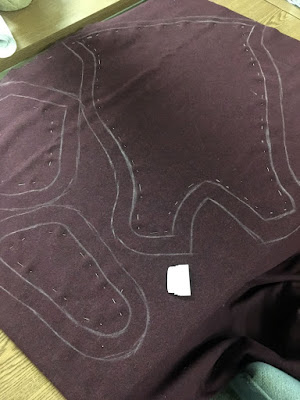I took...a lot of photos of this project. So many. Enough that cutting out the pieces gets one post, and constructing the hosen gets another.
 |
| Bias cutting is so great for fit on the body and so terrible for fit on the yardage. |
I was afraid 1.875 yards would be just barely enough for hosen. I didn't realize (or didn't quite...clock...) exactly how wide 58-inch fabric is, and it turns out I only need about .875 yards of such fabric to cut out knee-high hosen. Even with bias cutting, and napped fabric (very slightly napped, though, so that wasn't a huge factor). I folded the fabric in half crosswise, because...um. I'm sure there was a reason. No clue what it might have been.
Regardless, someday there'll be a winter skirt from the remainder, because that's how much there is.
 |
| Little bird ankles are far too small for great honking frog feet to squeeze through. |
I marked the outlines of my pieces with chalk after laying out the pattern and fiddling with it to create the largest remainder and smallest scraps possible, and adjusted the very close-fitted ankles to give my feet enough room to squeeze through that narrow point.
 |
| I measured my hands in middle school and discovered I have rulers attached to my wrists. |
I'd cut my pattern pieces without seam allowance, so I marked a one-inch allowance all the way around. Definitely excessive, but I much prefer having a little extra room for adjustment—and that goes double for the first time constructing a particular pattern. Besides, I'm already pretty attached to the idea of a blackberry-wine skirt, and having to recut pieces for hosen would seriously cramp my chances of getting a skirt from the remainder.
 |
| Told you they were giant seam allowances. |
Chalking done, I pinned the daylights out of the pieces to keep them from slipping around while I cut, and made a lot of red fuzz all over one of our unused desks at the office. Whoops.
 |
| This is closer to actual color than any of the others. |
I also cleverly marked each of the pieces for sidedness as I cut them, because playing "which leg does this belong to" is not my favorite activity.
 |
| There is a mistake in this photo. |
The last step before setting the pieces aside for the day was to baste the stitching lines before the chalk rubbed off; spongy, fulled wool makes a delightful garment, but a terrible substrate for dressmaker's chalk.






Comments
Post a Comment